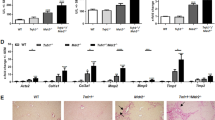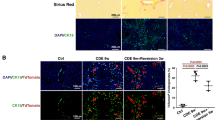Abstract
Following acute liver injury, hepatocytes divide to facilitate regeneration. However, during chronic injury, hepatocyte proliferation is typically blocked and repair is mediated through liver progenitor (oval) cells. Signalling of the p55 tumour necrosis factor (TNF) receptor is central to these processes. Two ligands for p55 are known: TNF and lymphotoxin-alpha (LTα). However, one study suggests that another exists that mediates liver injury following viral challenge. We have therefore investigated whether ligands other than TNF and LTα are required for liver regeneration following either acute or chronic injury. Wild-type and double TNF/LTα knockout (TNF−/−LTα−/−) mice were subjected to either partial hepatectomy (PHx) or a choline-deficient ethionine-supplemented (CDE) diet. Proliferating hepatocytes, oval cells and inflammatory cells were identified and quantified in liver sections by immunohistochemistry. Liver inflammatory cells were characterised by cell surface antigen expression. Liver damage and mortality were monitored. Both hepatocyte and oval cell proliferation was reduced in TNF−/−LTα−/− mice. Lymphocyte clusters were evident in all TNF−/−LTα−/− livers and were heterogeneous, comprising B and T lymphocytes. PHx evoked liver inflammation in TNF−/−LTα−/− but not wild-type mice, whereas no difference was apparent between genotypes in CDE experiments. Thus, TNF/LTα signalling mediates liver regeneration involving both hepatocytes and progenitor cells. The hyper-inflammatory response following PHx in TNF−/−LTα−/− animals, which is absent following CDE-induced injury, demonstrates that the two forms of liver injury evoke discrete inflammatory responses and provides a model in which such differences can be examined further.






Similar content being viewed by others
References
Akerman P, Cote P, Yang SQ, McClain C, Nelson S, Bagby GJ, Diehl AM (1992) Antibodies to tumor necrosis factor-alpha inhibit liver regeneration after partial hepatectomy. Am J Physiol 263:G579–G585
Alimzhanov MB, Kuprash DV, Kosco-Vilbois MH, Luz A, Turetskaya RL, Tarakhovsky A, Rajewsky K, Nedospasov SA, Pfeffer K (1997) Abnormal development of secondary lymphoid tissues in lymphotoxin beta-deficient mice. Proc Natl Acad Sci USA 94:9302–9307
Alison M, Golding M, Lalani e-N, Sarraf C (1998) Wound healing in the liver with particular reference to stem cells. Philos Trans R Soc Lond Biol 353:877–894
Banks TA, Rouse BT, Kerley MK, Blair PJ, Godfrey VL, Kuklin NA, Bouley DM, Thomas J, Kanangat S, Mucenski ML (1995) Lymphotoxin-alpha-deficient mice. Effects on secondary lymphoid organ development and humoral immune responsiveness. J Immunol 155:1685–1693
Croager EJ, Smith PG, Yeoh GC (2002) Ethanol interactions with a choline-deficient, ethionine-supplemented feeding regime potentiate pre-neoplastic cellular alterations in rat liver. Carcinogenesis 23:1685–1694
De Togni P, Goellner J, Ruddle NH, Streeter PR, Fick A, Mariathasan S, Smith SC, Carlson R, Shornick LP, Strauss-Schoenberger J, Russell JH, Karr R, Chaplin DD (1994) Abnormal development of peripheral lymphoid organs in mice deficient in lymphotoxin. Science 264:703–707
Farber E (1956) Similarities in the sequence of early histological changes induced in the liver of the rat by ethionine, 2-acetylaminofluorene and 3-methyl-4-dimethylaminoazobenzene. Cancer Res 16:142–148
Fausto N, Campbell JS (2003) The role of hepatocytes and oval cells in liver regeneration and repopulation. Mech Dev 120:117–130
Futterer A, Mink K, Luz A, Kosco-Vilbois MH, Pfeffer K (1998) The lymphotoxin beta receptor controls organogenesis and affinity maturation in peripheral lymphoid tissues. Immunity 9:59–70
Galun E, Axelrod JH (2002) The role of cytokines in liver failure and regeneration: potential new molecular therapies. Biochim Biophys Acta 1592:345–358
Hayder H, Blanden RV, Korner H, Riminton DS, Sedgwick JD, Mullbacher A (1999) Adenovirus-induced liver pathology is mediated through TNF receptors I and II but is independent of TNF or lymphotoxin. J Immunol 163:1516–1520
Kahn D, Robson SC, Hickman R (1994) The effect of a tumour necrosis factor antibody on the regenerative response after partial hepatectomy in rats. Transpl Int 7:S181–S182
Kang HS, Chin RK, Wang Y, Yu P, Wang J, Newell KA, Fu YX (2002) Signaling via LTbetaR on the lamina propria stromal cells of the gut is required for IgA production. Nat Immunol 3:576–582
Knight B, Yeoh GC, Husk KL, Ly T, Abraham LJ, Yu C, Rhim JA, Fausto N (2000) Impaired preneoplastic changes and liver tumor formation in tumor necrosis factor receptor type 1 knockout mice. J Exp Med 192:1809–1818
Korner H, Cook M, Riminton DS, Lemckert FA, Hoek RM, Ledermann B, Kontgen F, Fazekas de St Groth B, Sedgwick JD (1997) Distinct roles for lymphotoxin-alpha and tumor necrosis factor in organogenesis and spatial organization of lymphoid tissue. Eur J Immunol 27:2600–2609
Lowes KN, Brennan BA, Yeoh GC, Olynyk JK (1999) Oval cell numbers in human chronic liver diseases are directly related to disease severity. Am J Pathol 154:537–541
Lowes KN, Croager EJ, Olynyk JK, Abraham LJ, Yeoh GC (2003) Oval cell-mediated liver regeneration: role of cytokines and growth factors. J Gastroenterol Hepatol 18:4–12
Matsumoto M, Mariathasan S, Nahm MH, Baranyay F, Peschon JJ, Chaplin DD (1996) Role of lymphotoxin and the type I TNF receptor in the formation of germinal centers. Science 271:1289–1291
Michalopoulos GK, DeFrances MC (1997) Liver regeneration. Science 276:60–66
Neumann B, Luz A, Pfeffer K, Holzmann B (1996) Defective Peyer’s patch organogenesis in mice lacking the 55-kD receptor for tumor necrosis factor. J Exp Med 184:259–264
Pasparakis M, Alexopoulou L, Episkopou V, Kollias G (1996) Immune and inflammatory responses in TNF alpha-deficient mice: a critical requirement for TNF alpha in the formation of primary B cell follicles, follicular dendritic cell networks and germinal centers, and in the maturation of the humoral immune response. J Exp Med 184:1397–1411
Peschon JJ, Torrance DS, Stocking KL, Glaccum MB, Otten C, Willis CR, Charrier K, Morrissey PJ, Ware CB, Mohler KM (1998) TNF receptor-deficient mice reveal divergent roles for p55 and p75 in several models of inflammation. J Immunol 160:943–952
Roskams T, De Vos R, Van Eyken P, Myazaki H, Van Damme B, Desmet V (1998) Hepatic OV-6 expression in human liver disease and rat experiments: evidence for hepatic progenitor cells in man. J Hepatol 29:455–463
Sell S (2001) Heterogeneity and plasticity of hepatocyte lineage cells. Hepatology 33:738–750
Shinozuka H, Lombardi B, Sell S, Iammarino RM (1978) Early histological and functional alterations of ethionine liver carcinogenesis in rats fed a choline-deficient diet. Cancer Res 38:1092–1098
Wallach D, Varfolomeev EE, Malinin NL, Goltsev YV, Kovalenko AV, Boldin MP (1999) Tumor necrosis factor receptor and Fas signaling mechanisms. Annu Rev Immunol 17:331–367
Yamada Y, Fausto N (1998) Deficient liver regeneration after carbon tetrachloride injury in mice lacking type 1 but not type 2 tumor necrosis factor receptor. Am J Pathol 152:1577–1589
Yamada Y, Kirillova I, Peschon JJ, Fausto N (1997) Initiation of liver growth by tumor necrosis factor: deficient liver regeneration in mice lacking type I tumor necrosis factor receptor. Proc Natl Acad Sci USA 94:1441–1446
Yamada Y, Webber EM, Kirillova I, Peschon JJ, Fausto N (1998) Analysis of liver regeneration in mice lacking type 1 or type 2 tumor necrosis factor receptor: requirement for type 1 but not type 2 receptor. Hepatology 28:959–970
Yasui O, Miura N, Terada K, Kawarada Y, Koyama K, Sugiyama T (1997) Isolation of oval cells from Long-Evans Cinnamon rats and their transformation into hepatocytes in vivo in the rat liver. Hepatology 25:329–334
Author information
Authors and Affiliations
Corresponding author
Rights and permissions
About this article
Cite this article
Knight, B., Yeoh, G.C. TNF/LTα double knockout mice display abnormal inflammatory and regenerative responses to acute and chronic liver injury. Cell Tissue Res 319, 61–70 (2005). https://doi.org/10.1007/s00441-004-1003-6
Received:
Accepted:
Published:
Issue Date:
DOI: https://doi.org/10.1007/s00441-004-1003-6




